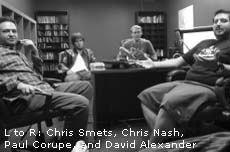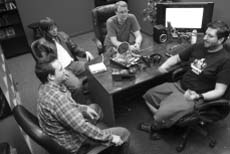A round-table discussion on indie-horror, by Paul Corupe
Horror novels, films and art-work may be intended primarily to scare audiences, but just as often, they end up inspiring them as well. In fact, few genres inspire burgeoning indie writers, directors and artists as deeply as horror–after all, what DIYer hasn’t spent their formative years penning a spooky story or making a homemade Super 8 monster movie in their backyard? Recently, Chris Nash, the writer/director of the indie horror/comedy short Day of John, Dave Alexander, managing editor of Rue Morgue magazine, Tony Burgess, the acclaimed author of horror novels The Hellmouths of Bewdley, Pontypool Changes Everything, and Caesarea, and Chris Smets, screenwriter of recent Canadian-shot features The Mad, Dead Mary and Living Death took part in a roundtable discussion at the Rue Morgue House of Horror in Toronto to explain why the horror genre plays such a prominent role in independent culture.
Generally speaking, why do you think so many indie artists are attracted to the horror genre?
Tony Burgess: Well, I believe horror is one of your first strong fascinations, so most people who are starting out as filmmakers or writers have already got a fascinating horror story in them. Plus, it’s a great way to offend people!
Dave Alexander: I also think that a big part of it is the “outsider art” factor. Personally, I was really into punk rock growing up, and horror films kind of go hand in hand with the punk ethic.
Where do you think this relationship between horror and the indie spirit comes from?
Chris Smets: Well, anything that’s done independently usually comes out of a frustration with the mainstream. Whether you’re banging out songs in your own band or making a low budget horror film, you’re doing it because popular culture isn’t doing it for you. For example, we saw a lot of PG-13 horror from the big studios in the late 1990s, and as a result, we had independent movies like Saw and Cabin Fever that broke out and became big hits after they got distribution. Regardless of how you may feel about those films, they were conceived as a reaction to the culture around them.
TB: There’s also a “Velvet Underground syndrome” at work too, where you hear an album or see a film, and figure you have enough things in the kitchen or your backyard to make something similar yourself. Everybody who saw a film like George A. Romero’s Night of the Living Dead wanted to go out and made a movie of their own. You can clearly see the tools that Romero used to make his film, unlike something like Star Wars.
Don’t a lot of upcoming writers and directors simply treat the horror genre as a stepping stone to bigger and better things, though?
Chris Nash: I think horror can be a great jumping off point for those who want to get noticed. But the thing with independent horror is a lot of people who aren’t fans look at it as something that’s easy. They figure all you have to do is throw some zombies and blood in there and an audience will buy it. Not a lot of thought or passion goes into it.
TB: Artists will often turn to horror because it’s a good career move, or the material is accessible. I understand that, but that’s the reason why so much of it is bad, because there aren’t a lot of people going into it thinking it’s going to be their lifelong work. So there are two types of people–those who are lifers, and I feel like I’m one of them, and those who are maybe in a reggae band on the weekend, but they work on horror films during the week. And I’ve met a lot of people like that.
Like much independently produced art, horror is often used as a medium for social commentary. Is that an important aspect for the indie horror artist?
CS: As far as film goes, Romero is the classic example. He was doing independent stuff on a very low budget that was very personal, and it would reflect what he was thinking or feeling about the world at large, whether it was through zombies, vampires, or some other monster. And I think that is something that can be really valuable about the genre–you can be scaring people and freaking them out, but still making valid points about the culture around you.
DA: That spirit is very much alive, too. I just returned from the Fantasia film festival, and the best film I saw there was a film called Mulberry Street that had that Romero social commentary front and centre. It was shot by a couple guys in New York for about $60,000 on digital video. They used one of the guy’s apartments, and redressed it again and again to make it look like different places. It uses disease-carrying rats to symbolize the growing class gap in New York City due to aggressive gentrification. The amount of creativity and hard work that went into it was absolutely inspiring.
Is indie horror something you consciously seek out?
CN: I wouldn’t say I necessarily seek out independently produced horror movies, but I don’t actively seek out studio-produced horror. With big theatrical films I feel like I’m never going to be missing out because I’ll always be able to find it at Blockbuster five years down the road. With indie horror, you’ve really got to seize the opportunity–there’s a chance that it will never get distribution and you’ll never be able to see it again.
CS: Absolutely, I’m an internet movie site junkie, and I’m always looking for films that are really great that I would never check out otherwise. That’s how I discovered Lucky McKee’s film May. He uses the horror genre to do something very personal, which is, I think, something we should all be striving for.
DA: It’s interesting you mention Lucky McKee, as he’s really the best of that. We know him a little bit through the magazine. He had a cult hit with May, and he got offers to do a studio film, The Woods. But it was an absolute nightmare from start to finish for him, he didn’t get say on anything, they didn’t want to let him use the team of people he works with. But if they accepted his vision, it probably would have been a decent movie.
What are some of the other advantages of working independently in a genre like horror?
TB: Once you start pushing around big places and big material, it can get out of hand. If you restrict everything, you’re thinking in a smaller box, and usually your intensity level just goes up. I totally think small is always better.
CS: And more relatable too.
TB: Right. For example, every “manifesto” horror film has been small and really low-budget.
Are there unique challenges for the indie Canadian horror artist?
DA: It’s harder to succeed, because it’s a smaller country with a smaller pool of everything. Still, I’d really like to see less of people trying to imitate American genre films all the time. I don’t need to see another film that has obviously got Canada stamped all over it, but they stick in a token American flag or license plate because somehow that makes it more sellable. I want to see films that are specific, I want to see stories about Canada or certain areas of Canada, and independent filmmakers have the power to do that.
TB: I think you totally sell your soul when you try to disguise a Canadian location as American. You’re saying that your story is weak and you don’t trust it. Even in writing, I’ve had agents talk to me about this, because every book I’ve ever written has the name of a small Ontario town in the title, and they’re very geographically specific.
CN: Besides, why not bring out these Canadian locations and make them cool? You could make your setting the next Quick Stop that every Kevin Smith fan wants to hang out at–why not have them come out to some convenience store in the west GTA?
Do you think it hurts horror to have so many competing indie artists vying for attention?
CN: Earlier we were comparing horror with the punk rock genre, and again, why would you want to be a horror filmmaker or in a punk band, because there’s so many of them out there? How are you going to get noticed? Sometimes I feel like I should write a good buddy comedy or something, but I know, somewhere within me, there’s a monster hiding in the closet.
TB: I think surviving the indie culture anywhere is its own sort of school. If you can learn how to cultivate your skills and your tools, your own fascination and love for things while failing, that will get you through.
CN: Totally. For everything I have done, there are about three things that I shot and maybe got halfway through editing and I realized they were not what I wanted to try to show, so nobody’s ever going to see them. But I’ve learned so much from them. It’s also inspiring that horror fans make up a close knit, supportive community. And they’re all creative in some way–I know that out of a group of people I just meet in line for the Toronto International Film Festival’s Midnight Madness program somebody’s going to be a sound engineer, somebody’s a makeup artist, somebody’s a writer and, well, everybody’s a musician!
TB: Yeah, it’s definitely a punk ethic. Just make shit happen!


